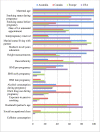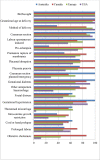The data we have: Pregnancy and birth related data collection in Australia, Canada, Europe and the USA - A web-based survey of practice
- PMID: 34164585
- PMCID: PMC8188524
- DOI: 10.23889/ijpds.v6i1.1378
The data we have: Pregnancy and birth related data collection in Australia, Canada, Europe and the USA - A web-based survey of practice
Abstract
Objectives: To determine the feasibility of combining routinely recorded perinatal data from several databases in high-income countries to assess the risk of recurrent stillbirth.
Methods: Web-based questionnaire survey with reminder emails and searching of relevant country websites.
Results: 120 countries/regions in Canada, Europe and the USA were invited to participate and 83 (69%) responded. Of those one had no data, and two did not wish to take part. The remaining 80 were sent the questionnaire and 63 (53%) were completed. Twenty-seven countries/regions reported that they collect information on all perinatal events (including early pregnancy loss), 34 on live births and stillbirths and two only live births (stillbirths recorded in a separate database). Most countries (53/63) can link two or more pregnancies occurring in the same woman. Data and information extracted from the Australian and New Zealand Government websites showed that information on all perinatal events is collected nationally in New Zealand and in 5/8 regions in Australia. Both Australia and New Zealand can link two or more pregnancies occurring in the same woman. Maternal age and caffeine consumption were the most and least consistently collected demographic indicators respectively. Diabetes mellitus and mental health problems, birthweight and obstetric cholestasis the most and least consistently collected for medical conditions and pregnancy condition/complications. Procedures for gaining access to data vary between countries.
Conclusion: This study demonstrates that it is possible to link pregnancies in the same woman to assess the risk of recurrent stillbirth using routinely collected perinatal data in all states/territories in Australia, 7/8 responding provinces/territories in Canada, 21/27 responding countries/regions in Europe, New Zealand and 26/28 responding states in the USA. The scope of the databases and quality and extent of data collected (thus their potential use) varied, as did procedures for accessing their data.
Keywords: Perinatal health, information systems; data; high-income countries; pregnancy.
Conflict of interest statement
Conflict of interest statement: The authors report no conflicts of interest
Figures



Similar articles
-
Beyond counting stillbirths to understanding their determinants in low- and middle-income countries: a systematic assessment of stillbirth data availability in household surveys.Trop Med Int Health. 2017 Mar;22(3):294-311. doi: 10.1111/tmi.12828. Epub 2017 Jan 22. Trop Med Int Health. 2017. PMID: 27992672
-
The feasibility of a clinical audit tool to investigate stillbirth in Australia - a single centre experience.Aust N Z J Obstet Gynaecol. 2019 Feb;59(1):59-65. doi: 10.1111/ajo.12799. Epub 2018 Mar 23. Aust N Z J Obstet Gynaecol. 2019. PMID: 29569709
-
Birth centers in Australia: a national population-based study of perinatal mortality associated with giving birth in a birth center.Birth. 2007 Sep;34(3):194-201. doi: 10.1111/j.1523-536X.2007.00171.x. Birth. 2007. PMID: 17718869
-
An international internet survey of the experiences of 1,714 mothers with a late stillbirth: the STARS cohort study.BMC Pregnancy Childbirth. 2015 Aug 15;15:172. doi: 10.1186/s12884-015-0602-4. BMC Pregnancy Childbirth. 2015. PMID: 26276347 Free PMC article.
-
Comparison of diabetes management in five countries for general and indigenous populations: an internet-based review.BMC Health Serv Res. 2010 Jun 17;10:169. doi: 10.1186/1472-6963-10-169. BMC Health Serv Res. 2010. PMID: 20553622 Free PMC article. Review.
References
-
- Euro-Peristat Project. European Perinatal Health Report. Core indicators of the health and care of pregnant women and babies in Europe in 2015. November 2018. Available www.europeristat.com
MeSH terms
LinkOut - more resources
Full Text Sources
Medical
